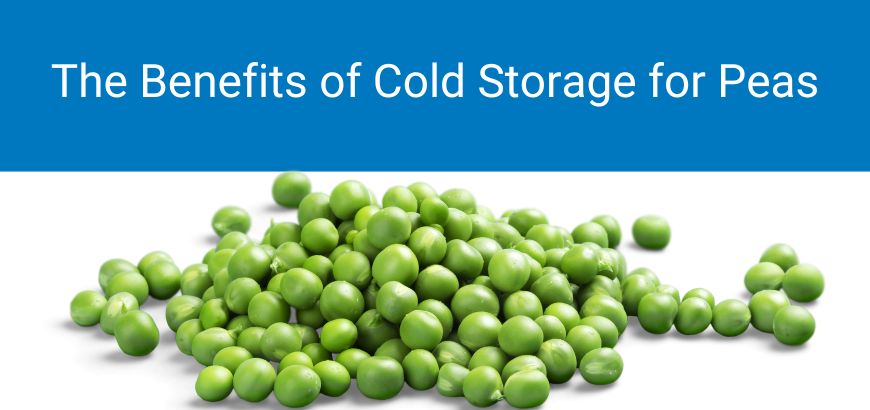The Benefits of Cold Storage for Peas

Admin
November 22, 2022


November 22, 2022

Green pea or garden pea is not an unfamiliar vegetable. Typically, a pod that is up to nine centimetres in length can contain four to nine pea seeds. Widely used across the Indian subcontinent as fresh, frozen, or canned, peas have high nutritional value and have been a part of the staple diet for a long time. Additionally, for the fact that they are only available during the winter season and have a shelf life of three to four days, cold storage of peas is important for the food industry.
So, let us dive deeper into how peas are processed and stored and what role is played by cold chain solutions.
Primarily, peas have been used for two requirements. Firstly, as a whole food that can be dried, processed, frozen, or canned. Secondly, as a source of ingredients (protein, starch or fibre) used in food manufacturing following further processing.
Like other vegetables, green peas also produce large amounts of heat after harvesting. That is why immediate post-harvest cooling can help in extending shelf-life. It can also reduce the effects of dehydration and the damage caused by decay-causing organisms. However, it should be noted that post-harvest cooling or precooling is important in maintaining quality but it will not improve the quality of poor produce.
Moreover, higher temperatures can also increase the rate of respiration and any delay in post-harvest cooling can lead to a loss in weight, quality and shrivelling.
Effect of delayed cooling on snap beans quality
| Delay Time (hours) | Weight Loss (%) |
|---|---|
| 1 | 2.2 |
| 3 | 2.8 |
| 5 | 10.0 |
Moreover, limiting the time between harvesting and cooling to not more than one or two hours will help maximize shelf life.
Since peas are highly perishable, fresh unshelled peas can be stored for around two weeks. Wilting, yellowing of pods, loss of tenderness, development of starchiness and decay are likely to increase following storage beyond 14 days and defects occur rapidly at common distribution conditions above 8°C.
The optimum storage temperature and relative humidity level for peas are 0°C (32°F) and 95 to 98% respectively for extended shelf life, without much weight loss.
Processed or shelled frozen peas, on the other hand, can be stored at -23 to -18°C for a year in gas-tight packaging. Additionally, high moisture content makes it important that peas be well preserved using any method such as freezing, drying, canning, or cold storage to extend their shelf-life.
Generally, green peas are processed in the following two ways:
When it comes to peas, freezing is a very effective preservation method that helps maintain their quality and freshness. It is an easy and less time-consuming method and also retains more nutrients. Many experts agree that freezing is in fact a much better way to preserve the flavour and texture than canning.
Natural enzymes in the peas can cause damage but freezing can delay the enzymatic activity and prevents the growth of spoilage-causing microorganism. Therefore, vegetables are usually blanched in boiling water or steamed for a short time period prior to freezing for 90 to 120 seconds. Overcooking the peas can leave them too mushy once you reheat them.
During storage of frozen vegetables, loss of moisture can lead to tough texture and dryness as well as off-flavours. This problem can be solved in two ways:
Peas are blanched, drained, and frozen such that the range of temperature of maximum crystallization is crossed quickly. This quick freezing process is considered complete when the product reaches a temperature of -18 °C or lower after thermal stabilization. It involves freezing the water inside the cellular spaces of tissue in the fruit. The idea is to freeze this water so quickly that ice crystals formed are much smaller and do not damage the structure or integrity of the food products. This method is popularly known as individual quick freezing or IQF.
The IQF method involves the following two types of equipment.
The IQF frozen peas can be packaged suitably and should be stored in a freezer room where the temperature is maintained at less than -20°C.
Since peas are harvested seasonally, feezing is one of the best methods to preserve their freshness, especially if you have a bumper crop and cannot keep up with them. Also, thawed peas do not lose much of their fresh flavour, texture, or nutrient content.
Cold storage of peas is an important process for the food processing and manufacturing industry. With the right processing and cold storage conditions, the shelf life of garden peas can be extended up to a year. This is where choosing reliable and durable cold storage solutions can make a difference.
Rinac’s Freezoline offers advanced technology to ensure superior, just fresh-like texture and flavour of the produce. Our Fresh Produce Processing Technologies partner with farmers and next-level processers to deliver high-quality fruits and vegetables to consumers around the globe.
Check out our premium quality Individual Quick Freezers (IQF) with fluidisation and air impingement technology today!
